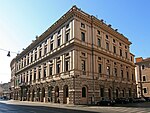Abbot Luigi

Abbot Luigi (Romanesco: Abbate Luiggi; Italian: Abate Luigi) is one of the talking statues of Rome. Like the other five "talking statues", pasquinades - irreverent satires poking fun at public figures - were posted beside Abate Luigi in the 14th and 15th centuries. The statue is a late Roman sculpture of a standing man in a toga, probably a senior magistrate. It was found during the excavations for the foundations of the Palazzo Vidoni-Caffarelli, near the Theatre of Pompey. After being moved to various locations in Rome, the statue has been situated in the piazza Vidoni since 1924, near its place of discovery, on a side wall of the Basilica di Sant'Andrea della Valle. Its head has been removed in jest several times. The original identity of the person depicted has not been determined, and it was named after a clergyman from the nearby chiesa del Sudario. An inscription on its plinth testifies to Abate Luigi's loquacity:
Excerpt from the Wikipedia article Abbot Luigi (License: CC BY-SA 3.0, Authors, Images).Abbot Luigi
Piazza Vidoni, Rome Municipio Roma I
Geographical coordinates (GPS) Address Nearby Places Show on map
Geographical coordinates (GPS)
| Latitude | Longitude |
|---|---|
| N 41.896056 ° | E 12.474556 ° |
Address
Basilica di Sant'Andrea della Valle
Piazza Vidoni
00186 Rome, Municipio Roma I
Lazio, Italy
Open on Google Maps









